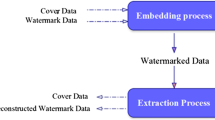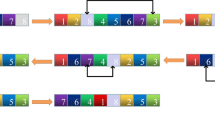Abstract
Over the years, different watermarking techniques have been used for medical image authentication purposes. Some techniques have been presented to detect tampering in the medical image while others can also recover the tampered region after the tamper detection. Many of the previous medical image authentication schemes have successfully achieved their aims; however, the robustness of the authentication scheme against unintentional attacks has not been highlighted sufficiently. This paper presents a new medical image authentication scheme in which the medical image is divided into two regions (i.e., region of interest (ROI) and region of non-interest (RONI)). Then two watermarking methods based on Slantlet transform (SLT) are used to embed data in the ROI and the RONI. The proposed scheme can be used for tamper detection, localization, and recovery in addition to the data hiding. To generate the recovery information of the ROI, a new method has been proposed based on the integer wavelet transform (IWT) coefficients. The experiments that have been conducted to evaluate the proposed authentication scheme proved that it is efficient not only in achieving its main tasks that have been mentioned above but also in having robustness against unintentional attacks (i.e., JPEG compression, additive Gaussian noise (AGN), and salt-and-pepper noise) and that makes it more suitable for the practical applications.










Similar content being viewed by others
References
Abokhdair NO, Manaf ABA (2013) “A review of reversible watermarking properties, applications, and techniques for medical images,” 6th International Conference on Information Technology ICIT, Amman, Jordan
Al-Qershi OM, and Khoo BE (2009) “Authentication and data hiding using a reversible ROI-based watermarking scheme for DICOM images,” Int Conf Med Syst Eng (ICMSE) 829–834
Al-Qershi OM, Khoo BE (2011) Authentication and data hiding using a hybrid ROI-based watermarking scheme for DICOM images. J Digit Imaging 24(1):114–125
An L, Gao X, Li X, Tao D, Deng C, Li J (2012) Robust reversible watermarking via clustering and enhanced pixel-wise masking. IEEE Trans Image Process 21(8):3598–3611
An L, Gao X, Yuan Y, Tao D (2012) “Robust lossless data hiding using clustering and statistical quantity histogram. Neurocomputing 77(1):1–11
Chiang K, Chang-Chien K, Chang R, Yen H (2008) Tamper detection and restoring system for medical images using wavelet-based reversible data embedding. J Digit Imaging 21(1):77–90
Giakoumaki A, Pavlopoulos S, Koutsouris D (2006) Multiple image watermarking applied to health information management. IEEE Trans Inf Technol Biomed 10(4):722–732
Giakoumaki A, Pavlopoulos S, Koutsouris D (2006) Secure and efficient health data management through multiple watermarking on medical images. Med Biol Eng Comput 44(8):619–631
Guo X, Zhuang T-g (2009) A region-based lossless watermarking scheme for enhancing security of medical data. J Digit Imaging 22(1):53–64
Kulkarni MB, Patil RT (2012) Tamper detection & recovery in medical image with secure data hiding using reversible watermarking. Int J Emerg Technol Adv Eng 2(3):370–373
Kundur D and Hatzinakos D (1999) “Digital watermarking for telltale tamper proofing and authentication,” Proc IEEE
Memon NA (2010) “Watermarking of medical images for content authentication and copyright protection,” Ph.D. Thesis, Ghulam Ishaq Khan Institute of Engineering Science and Technology
Memon NA, Gilani SA (2011) Watermarking of chest CT scan medical images for content authentication. Int J Comput Math 88(2):265–280
Memon NA, Gilani SAM and Ali A (2009) “Watermarking of chest CT scan medical images for content authentication,” Int Conf Inform Commun Technol, ICICT 175–180
Mohammed RT and Khoo BE (2012) “Image watermarking using slantlet transform,” IEEE Symp Indust Electron Applic (ISIEA) 281–286
Mostafa S, El-sheimy N, Tolba A, Abdelkader F, Elhindy H (2010) Wavelet packets-based blind watermarking for medical image management. Open Biomed Eng J 4:93–98
Naseem MT, Qureshi IM, Cheema TA, Atta-ur-Rahman (2013) Hash based medical image authentication and recovery using chaos and residue number system. J Basic Appl Sci Res 3(6):488–495
Nayak J, Bhat P, Kumar M, and Acharya U (2004) “Reliable transmission and storage of medical images with patient information using error control codes,” India Ann Conf, Proc IEEE INDICON 147–150
Thabit R, Khoo BE (2014) Robust reversible watermarking scheme using slantlet transform matrix. J Syst Softw 88:74–86
Thabit R, Khoo BE (2015) A new robust lossless data hiding scheme and its application to color medical images. Digit Sign Process 38:77–94
Tian J (2003) Reversible data embedding using a difference expansion. IEEE Trans Circ Syst Video Technol 13(8):890–896
Woo C, Du J, and Pham B (2005) “Multiple watermark method for privacy control and tamper detection in medical images,” Proc APRS Workshop Digit Imag Comput Pattern Recognit Imag Med Applic 43–48
Wu J, Chang R, Chen C, Wang C, Kuo T, Moon W, Chen D (2008) Tamper detection and recovery for medical images using near lossless information hiding technique. J Digit Imaging 21:59–76
Zain J, Baldwin L and Clarke M (2004) “Reversible watermarking for authentication of DICOM images,” Proc 26th Ann Int Conf IEEE Eng Med Biol Soc
Zain J, Clarke M (2007) Reversible region of non-interest (RONI) watermarking for authentication of DICOM images. Int J Comput Sci Network Sec 7(9):19–28
Zain J, and Fauzi A (2006) “Medical image watermarking with tamper detection and recovery,” Proc 28th IEEE EMBS Ann Int Conf 3270–3273
Zain J, and Fauzi A (2007) “Evaluation of medical image watermarking with tamper detection and recovery (AW-TDR),” 29th Ann Int Conf IEEE Eng Med Biol Soc (EMBS) 5661–5664
Author information
Authors and Affiliations
Corresponding author
Rights and permissions
About this article
Cite this article
Thabit, R., Khoo, B.E. Medical image authentication using SLT and IWT schemes. Multimed Tools Appl 76, 309–332 (2017). https://doi.org/10.1007/s11042-015-3055-x
Received:
Revised:
Accepted:
Published:
Issue Date:
DOI: https://doi.org/10.1007/s11042-015-3055-x




